Effectiveness of Profile Injecting Attack Against Recommender System
VerifiedAdded on 2023/06/15
|7
|821
|226
Report
AI Summary
This report examines the effectiveness of profile injecting attacks against recommender systems, highlighting the vulnerabilities of collaborative recommender systems to such attacks, also known as shilling attacks. It aims to identify approaches for detecting these attacks with monitored cataloging, reviewing various vulnerabilities in recommendation techniques and recognizing different attack models based on attacker knowledge and intent. The study emphasizes the significance of understanding profile injection attacks for the overall dynamism of recommender systems, demonstrating how classifier learning can differentiate real data from attack data to limit damages. The design scope focuses on reviewing attack models, detecting profile injection attacks, and classifying profiles, drawing from literature on attack models, detection methods, and profile classification techniques to address the challenge of maintaining the integrity of recommender systems.
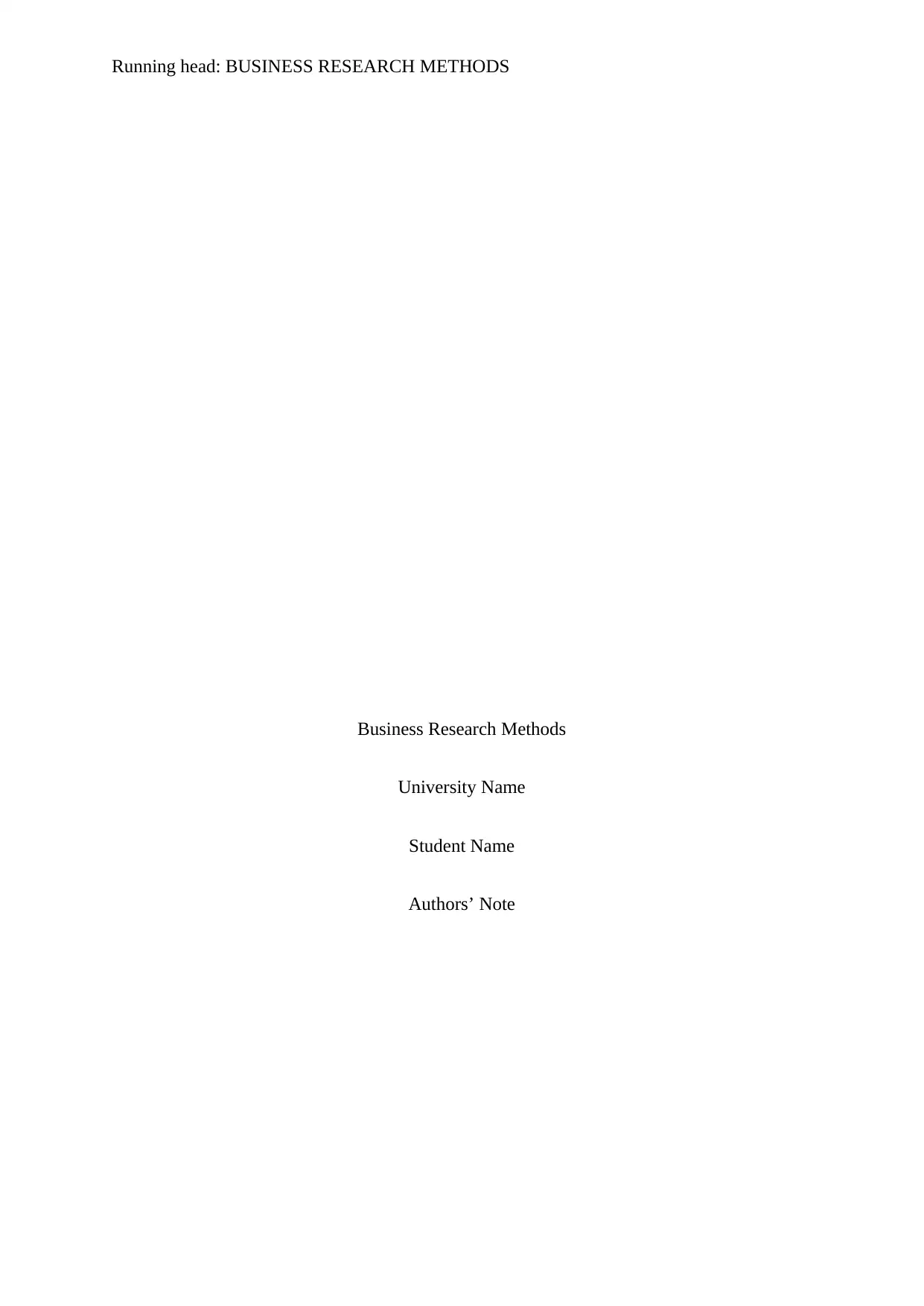
Running head: BUSINESS RESEARCH METHODS
Business Research Methods
University Name
Student Name
Authors’ Note
Business Research Methods
University Name
Student Name
Authors’ Note
Paraphrase This Document
Need a fresh take? Get an instant paraphrase of this document with our AI Paraphraser

2
BUSINESS RESEARCH METHODS
Table of Contents
1.1 Background of the study......................................................................................................2
1.2 Statement of problem...........................................................................................................2
1.3 Aims and objectives.............................................................................................................2
1.4 Significance of the study......................................................................................................4
1.5The Design Scope.................................................................................................................4
2.0 Literature Review.................................................................................................................4
2.1 Attack Model........................................................................................................................4
2.3 Profile Classification............................................................................................................5
3.0 Organization of the design...................................................................................................5
References..................................................................................................................................7
BUSINESS RESEARCH METHODS
Table of Contents
1.1 Background of the study......................................................................................................2
1.2 Statement of problem...........................................................................................................2
1.3 Aims and objectives.............................................................................................................2
1.4 Significance of the study......................................................................................................4
1.5The Design Scope.................................................................................................................4
2.0 Literature Review.................................................................................................................4
2.1 Attack Model........................................................................................................................4
2.3 Profile Classification............................................................................................................5
3.0 Organization of the design...................................................................................................5
References..................................................................................................................................7
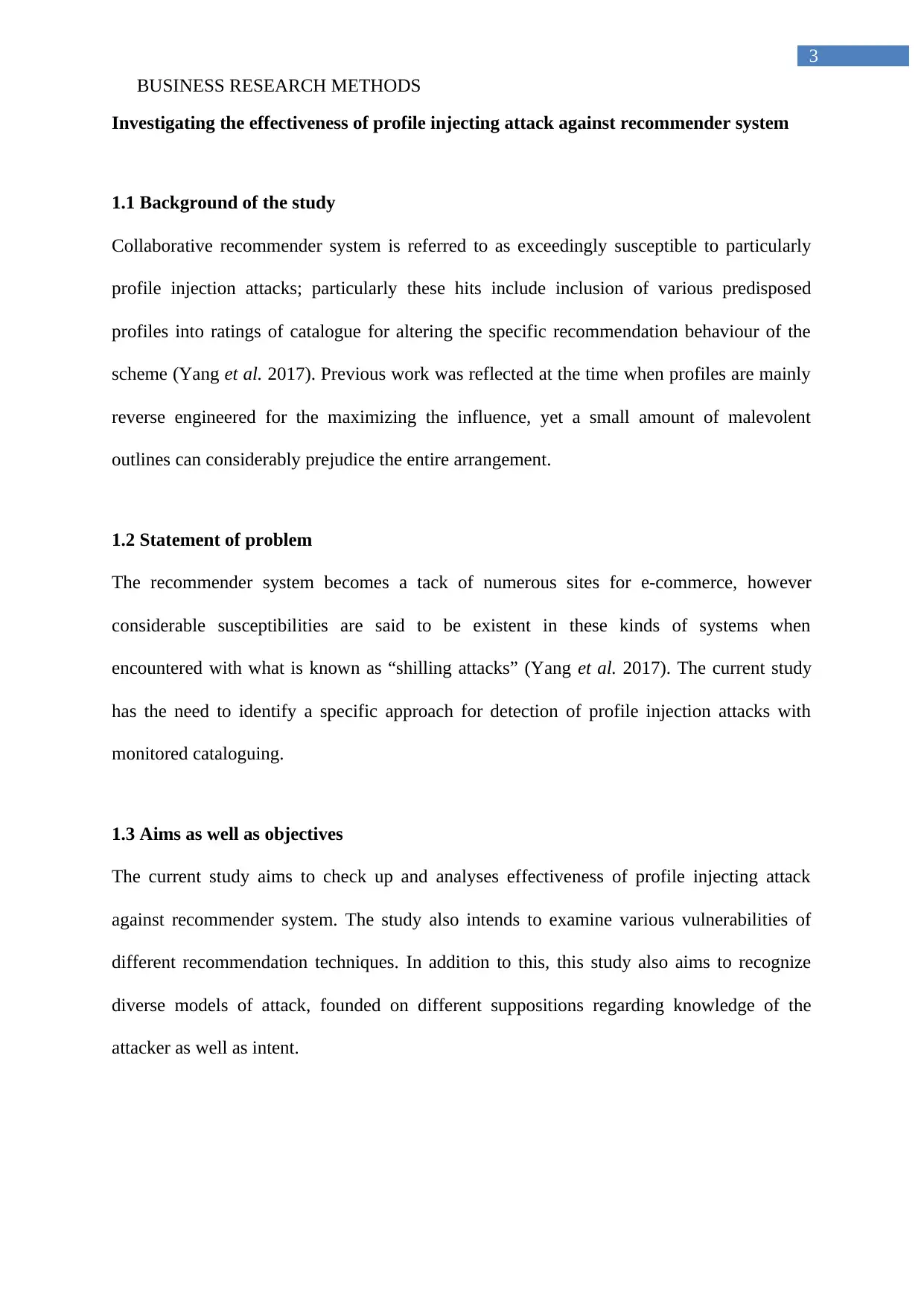
3
BUSINESS RESEARCH METHODS
Investigating the effectiveness of profile injecting attack against recommender system
1.1 Background of the study
Collaborative recommender system is referred to as exceedingly susceptible to particularly
profile injection attacks; particularly these hits include inclusion of various predisposed
profiles into ratings of catalogue for altering the specific recommendation behaviour of the
scheme (Yang et al. 2017). Previous work was reflected at the time when profiles are mainly
reverse engineered for the maximizing the influence, yet a small amount of malevolent
outlines can considerably prejudice the entire arrangement.
1.2 Statement of problem
The recommender system becomes a tack of numerous sites for e-commerce, however
considerable susceptibilities are said to be existent in these kinds of systems when
encountered with what is known as “shilling attacks” (Yang et al. 2017). The current study
has the need to identify a specific approach for detection of profile injection attacks with
monitored cataloguing.
1.3 Aims as well as objectives
The current study aims to check up and analyses effectiveness of profile injecting attack
against recommender system. The study also intends to examine various vulnerabilities of
different recommendation techniques. In addition to this, this study also aims to recognize
diverse models of attack, founded on different suppositions regarding knowledge of the
attacker as well as intent.
BUSINESS RESEARCH METHODS
Investigating the effectiveness of profile injecting attack against recommender system
1.1 Background of the study
Collaborative recommender system is referred to as exceedingly susceptible to particularly
profile injection attacks; particularly these hits include inclusion of various predisposed
profiles into ratings of catalogue for altering the specific recommendation behaviour of the
scheme (Yang et al. 2017). Previous work was reflected at the time when profiles are mainly
reverse engineered for the maximizing the influence, yet a small amount of malevolent
outlines can considerably prejudice the entire arrangement.
1.2 Statement of problem
The recommender system becomes a tack of numerous sites for e-commerce, however
considerable susceptibilities are said to be existent in these kinds of systems when
encountered with what is known as “shilling attacks” (Yang et al. 2017). The current study
has the need to identify a specific approach for detection of profile injection attacks with
monitored cataloguing.
1.3 Aims as well as objectives
The current study aims to check up and analyses effectiveness of profile injecting attack
against recommender system. The study also intends to examine various vulnerabilities of
different recommendation techniques. In addition to this, this study also aims to recognize
diverse models of attack, founded on different suppositions regarding knowledge of the
attacker as well as intent.
⊘ This is a preview!⊘
Do you want full access?
Subscribe today to unlock all pages.

Trusted by 1+ million students worldwide
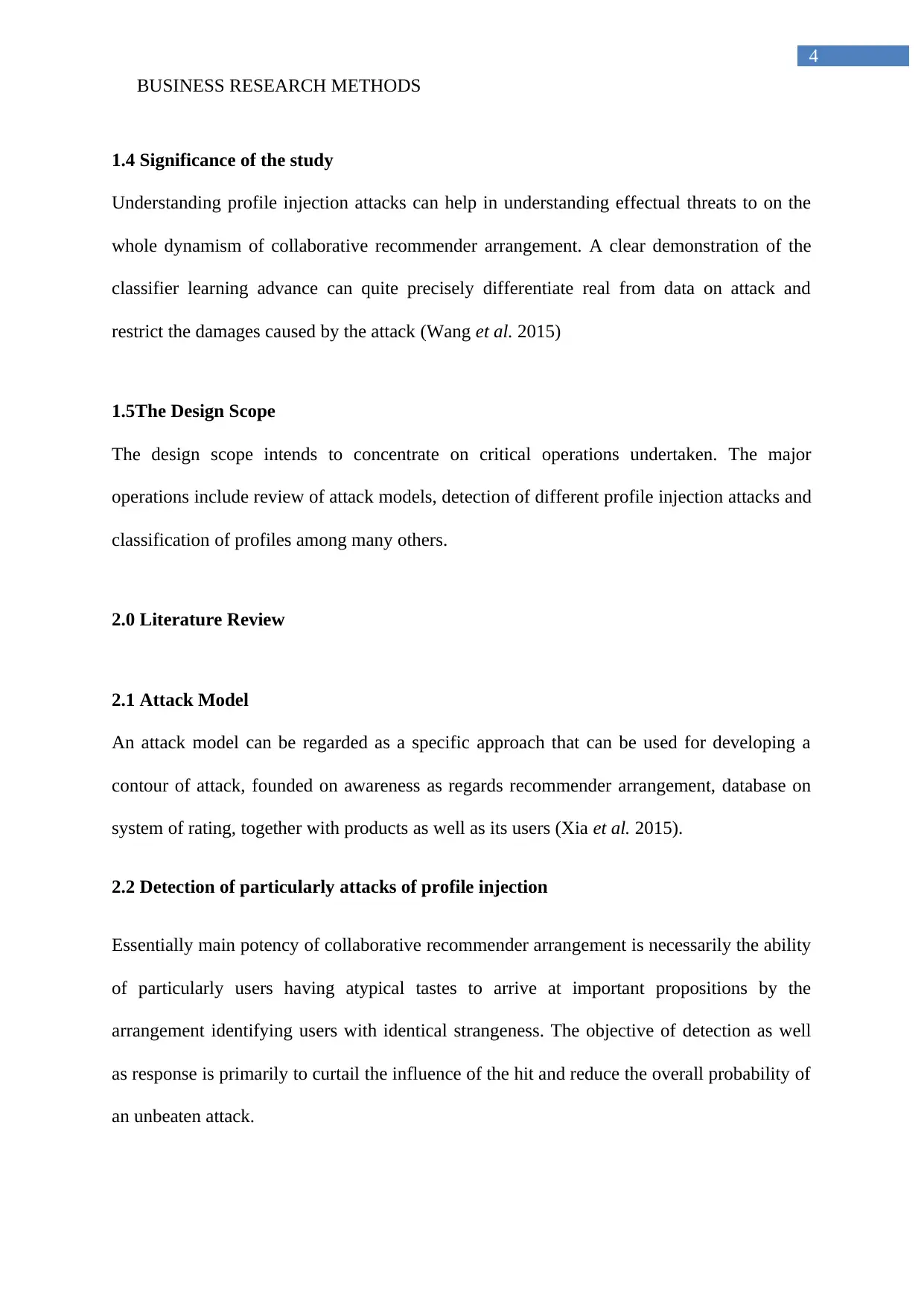
4
BUSINESS RESEARCH METHODS
1.4 Significance of the study
Understanding profile injection attacks can help in understanding effectual threats to on the
whole dynamism of collaborative recommender arrangement. A clear demonstration of the
classifier learning advance can quite precisely differentiate real from data on attack and
restrict the damages caused by the attack (Wang et al. 2015)
1.5The Design Scope
The design scope intends to concentrate on critical operations undertaken. The major
operations include review of attack models, detection of different profile injection attacks and
classification of profiles among many others.
2.0 Literature Review
2.1 Attack Model
An attack model can be regarded as a specific approach that can be used for developing a
contour of attack, founded on awareness as regards recommender arrangement, database on
system of rating, together with products as well as its users (Xia et al. 2015).
2.2 Detection of particularly attacks of profile injection
Essentially main potency of collaborative recommender arrangement is necessarily the ability
of particularly users having atypical tastes to arrive at important propositions by the
arrangement identifying users with identical strangeness. The objective of detection as well
as response is primarily to curtail the influence of the hit and reduce the overall probability of
an unbeaten attack.
BUSINESS RESEARCH METHODS
1.4 Significance of the study
Understanding profile injection attacks can help in understanding effectual threats to on the
whole dynamism of collaborative recommender arrangement. A clear demonstration of the
classifier learning advance can quite precisely differentiate real from data on attack and
restrict the damages caused by the attack (Wang et al. 2015)
1.5The Design Scope
The design scope intends to concentrate on critical operations undertaken. The major
operations include review of attack models, detection of different profile injection attacks and
classification of profiles among many others.
2.0 Literature Review
2.1 Attack Model
An attack model can be regarded as a specific approach that can be used for developing a
contour of attack, founded on awareness as regards recommender arrangement, database on
system of rating, together with products as well as its users (Xia et al. 2015).
2.2 Detection of particularly attacks of profile injection
Essentially main potency of collaborative recommender arrangement is necessarily the ability
of particularly users having atypical tastes to arrive at important propositions by the
arrangement identifying users with identical strangeness. The objective of detection as well
as response is primarily to curtail the influence of the hit and reduce the overall probability of
an unbeaten attack.
Paraphrase This Document
Need a fresh take? Get an instant paraphrase of this document with our AI Paraphraser
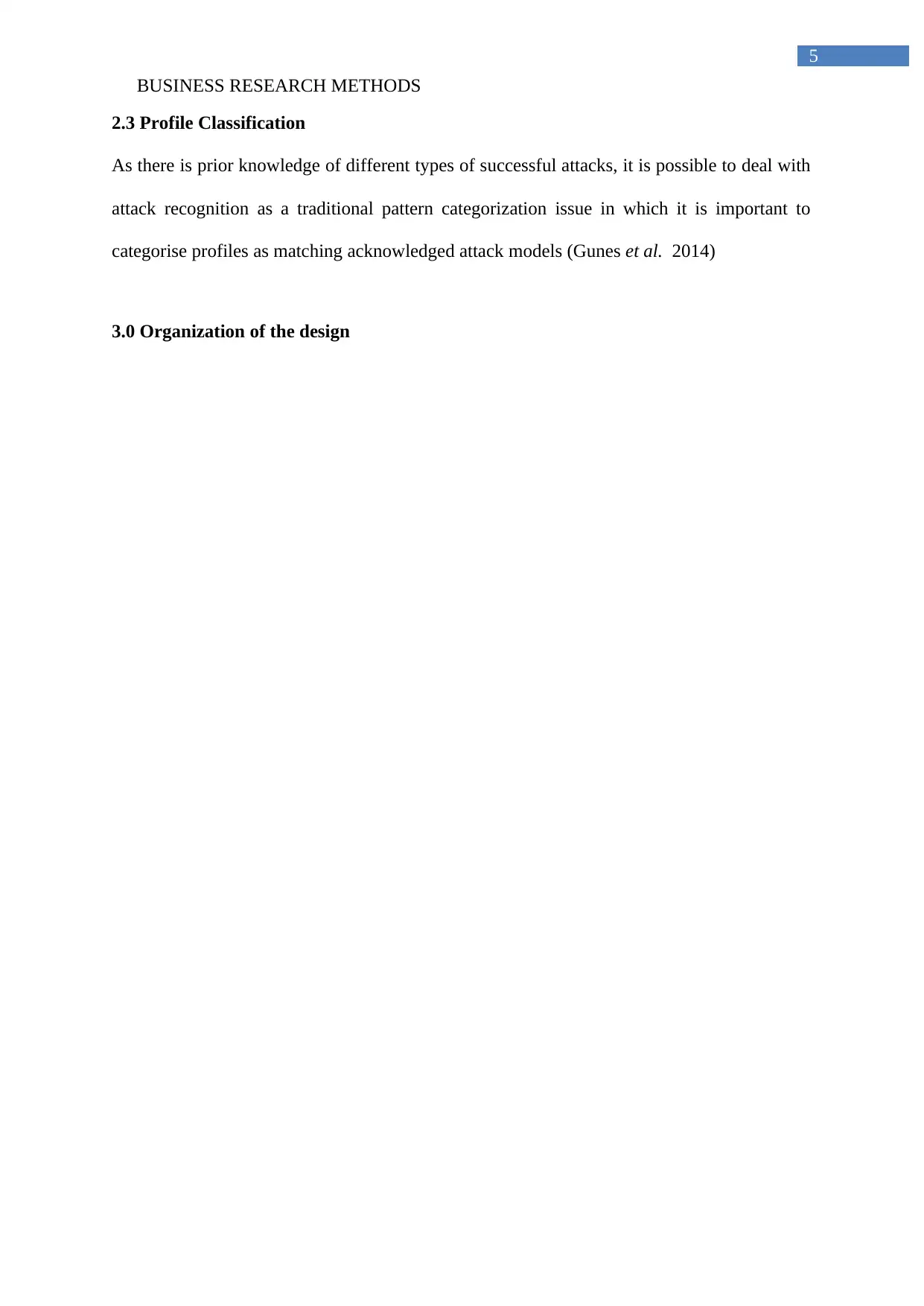
5
BUSINESS RESEARCH METHODS
2.3 Profile Classification
As there is prior knowledge of different types of successful attacks, it is possible to deal with
attack recognition as a traditional pattern categorization issue in which it is important to
categorise profiles as matching acknowledged attack models (Gunes et al. 2014)
3.0 Organization of the design
Chapterone-PresentingbackgroundofthestudyChaptertwo-DealswithreviewofliteraturerelatedtotheprojectChapterthree-ExplainsmethodofanalysisofandresearchmethodologyChapterfour-PresentstheanalysisanddocumentationoftherecordsChapterfive-Summarizingtheprojectanddrawingconclusions
BUSINESS RESEARCH METHODS
2.3 Profile Classification
As there is prior knowledge of different types of successful attacks, it is possible to deal with
attack recognition as a traditional pattern categorization issue in which it is important to
categorise profiles as matching acknowledged attack models (Gunes et al. 2014)
3.0 Organization of the design
Chapterone-PresentingbackgroundofthestudyChaptertwo-DealswithreviewofliteraturerelatedtotheprojectChapterthree-ExplainsmethodofanalysisofandresearchmethodologyChapterfour-PresentstheanalysisanddocumentationoftherecordsChapterfive-Summarizingtheprojectanddrawingconclusions
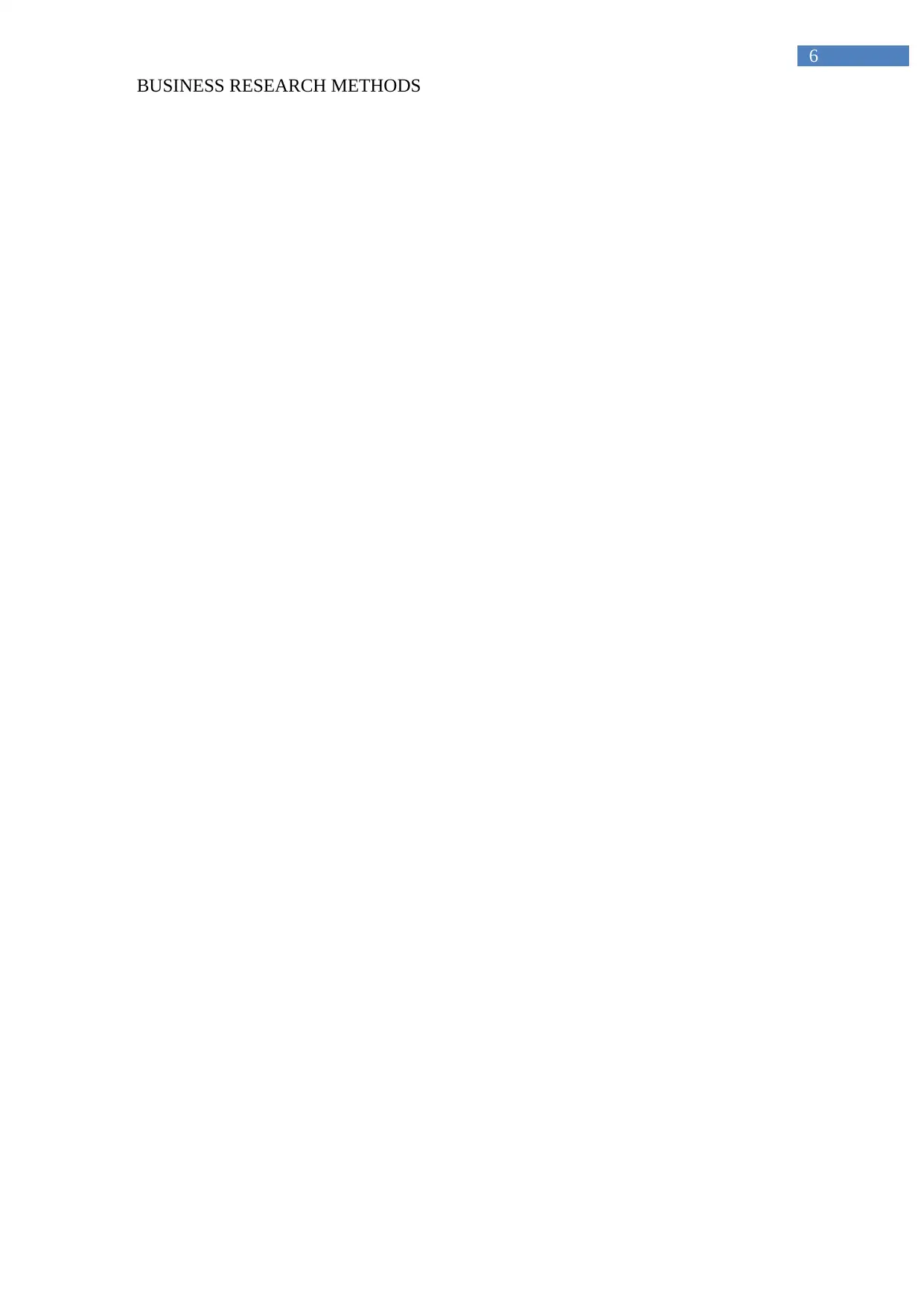
6
BUSINESS RESEARCH METHODS
BUSINESS RESEARCH METHODS
⊘ This is a preview!⊘
Do you want full access?
Subscribe today to unlock all pages.

Trusted by 1+ million students worldwide

7
BUSINESS RESEARCH METHODS
References
Gunes, I., Kaleli, C., Bilge, A. and Polat, H. Shilling attacks against recommender systems: a
comprehensive survey. Artificial Intelligence Review, 42(4), pp.767-799, 2014
Xia, H., Fang, B., Gao, M., Ma, H., Tang, Y. and Wen, J. A novel item anomaly detection
approach against shilling attacks in collaborative recommendation systems using the dynamic
time interval segmentation technique. Information Sciences, 306, pp.150-165, 2015
Wang, Y., Zhang, L., Tao, H., Wu, Z. and Cao, J. A comparative study of shilling attack
detectors for recommender systems. In Service Systems and Service Management (ICSSSM),
2015 12th International Conference on (pp. 1-6), June 2015
Yang, L., Huang, W. and Niu, X. Defending shilling attacks in recommender systems using
soft co-clustering. IET Information Security, 11(6), pp.319-325, 2017
BUSINESS RESEARCH METHODS
References
Gunes, I., Kaleli, C., Bilge, A. and Polat, H. Shilling attacks against recommender systems: a
comprehensive survey. Artificial Intelligence Review, 42(4), pp.767-799, 2014
Xia, H., Fang, B., Gao, M., Ma, H., Tang, Y. and Wen, J. A novel item anomaly detection
approach against shilling attacks in collaborative recommendation systems using the dynamic
time interval segmentation technique. Information Sciences, 306, pp.150-165, 2015
Wang, Y., Zhang, L., Tao, H., Wu, Z. and Cao, J. A comparative study of shilling attack
detectors for recommender systems. In Service Systems and Service Management (ICSSSM),
2015 12th International Conference on (pp. 1-6), June 2015
Yang, L., Huang, W. and Niu, X. Defending shilling attacks in recommender systems using
soft co-clustering. IET Information Security, 11(6), pp.319-325, 2017
1 out of 7
Related Documents
Your All-in-One AI-Powered Toolkit for Academic Success.
+13062052269
info@desklib.com
Available 24*7 on WhatsApp / Email
![[object Object]](/_next/static/media/star-bottom.7253800d.svg)
Unlock your academic potential
Copyright © 2020–2025 A2Z Services. All Rights Reserved. Developed and managed by ZUCOL.





